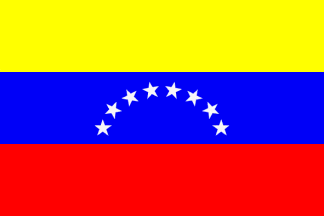 (2:3)
(2:3) 
National and State Flag
image by Pascal Gross, 13 March 2006

Last modified: 2007-06-16 by dov gutterman
Keywords: venezuela | america | bolivar | star |
Links: FOTW homepage |
search |
disclaimer and copyright |
write us |
mirrors
 (2:3)
(2:3) 
National and State Flag
image by Pascal Gross, 13 March 2006
 (2:3)
(2:3) 
"Civil" Flag
image by Pascal Gross, 13 March 2006
Official Name: Bolivarian Republic of
Venezuela (República Bolivariana de Venezuela)
Capital: Caracas
Location: South America
Government Type: Federal Republic
Flag adopted: 12
March 2006
ISO Code: VE
See:
See also:
From Agence France Presse, November 13, 1999 :
"Venezuela changes name to "Bolivarian Republic
of Venezuela"
Venezuela's Constitutional Assembly on Friday approved a name
change for the country, which in the future will be called the
Bolivarian Republic of Venezuela.
Venezuelan President Hugo Chavez has said the name change was an
essential part of his "revolutionary project" to change
the country's constitution.
"Bolivarian" referes to revolutionary figure and
national hero Simon Bolivar.
Members of a style commission agreed the text of the name change,
although it has not yet been decided when the name change would
go into effect. "
David Fowler , 14 November 1999
Venezuela has, if the people give a YES vote to this
Constitutional change and a new name: República Bolivariana de
Venezuela. However, the Flag will remain the same.
Guillermo Aveledo , 14 November 1999
at <www.ucab.edu.ve> (defunct) one finds:
"Our flag is made up of three horizontal stripes of equal
width. Yellow stands for the richnesses of the territory, blue
for the sea separating us from Spain and red for the blood shed
by our patriots during the Independence [War].
Our national flag was brought by General Francisco de Miranda in
his second expedition on March 12th, 1806 into "Vela de
Coro" ; this is why the Flag Day is held on March 12th. It
was recognised as national standard by Congress on July 15th,
1811 and was firstly hoisted as such on July 14th that
year."
Santiago Dotor , 30 December 1998
Coro, which is the oldest city in the mainland of Venezuela,
is directly on the shoreline. A lookout post was placed north of
the city, and was named "La Vela de Coro", literally
"The watch over Coro". The Spanish word
"vela" can both mean sail and vigil. This later is the
correct sense of this word, the place where the vigil, the watch,
took place.
Ricardo Kowalski, 15 September 1999
Flags in Venezuela are made in a very informal, quite crafty
way. As far as I know, There isn't any official guideline or
chart for the construction of the national flag, so there are
flags with smaller stars, narrower archs, longer stripes,
different colours.In the current constitution, it says, about the
flag, that this is the tricolori of yellow, blue and red.
Plain and simple. Not much further explanatios are set in the law
of National Symbols.
Guillermo Tell, 5 November 1999
No official shades have been issued with regard to either the
stripes or the arms, and no recommendations for the arms are
given in any official source. However, the UK Flag
Institute give yellow PMS 109C, blue PMS 280C and red 032C, BR20:
Yellow, red PMS 186C and blue PMS 280C, and the Album des
Pavillons yellow 116C, blue 286C and red 186C.
Christopher Southworth, 4 Maech 2005
Translated from From <www.asambleanacional.gov.ve>:
"Article 3. The National Flag is inspired by the flag
adopted by the Congress of the Republic in 1811. It
consists of the colors yellow, blue and red, in united, equal and
horizontal stripes, in the preceding order from top to bottom,
and, in the midst of the blue stripe, eight five-pointed white
stars placed in an upwardly convex arc of a circle. The National
Flag used by the Presidency of the Republic and by the National
Armed Forces, as well as those hoisted upon national, state, and
municipal public buildings, shall include the Coat of Arms of the
Bolivarian Republic of Venezuela at the edge of the yellow stripe
near the hoist. The National Flag used by the Merchant
marine shall bear only the eight stars.
Eugene Ipavec, 9 March 2006
The 2006 Flags are based on drawings available at <www.asambleanacional.gov.ve>.
Pascal Fross, 13
By decree signed on 3 July 1963, President of the Republic of
Venezuela Rómulo Betancourt prescribed the 12th March as the
Flag Day (Día de la Bandera).
This Day commemorates 12 March 1806, when Miranda hoisted for the
first time the flag of freedom on the vessel "Leandro",
in the bay of Jacmel in Haiti, and Miranda's first revolutionary
expedition. This Day has to be historically considered
with 3 August 1806, the day Miranda hoisted the flag for the
first time on the territory of Venezuela, and on Sunday 14 July
1811, the day when Prudencio and José María, the
sons José María España, hoisted for the first time on the
great square of Caracas the Tricolor flag selected by the
Constituent Assembly (Congreso Constituyente).
Source: Rafael Marrón González, Venezolanidad -
Venezuela en mil preguntas (LXXXVIII) "Correo
del Caroní", 12 November 2005.
The 1806 events are described with more details on Venezuela - Historical Flags.
Ivan Sache, 20 November 2005
On 21 August 2006, the Council of the Ministers of Venezuela
approved the Decree prescribing the change of the National Flag
Day from the 12 March for the 3 August. The change was required
by President of the Republic Hugo Chávez, in order to celebrate
the national flag on the day when Francisco de Miranda hoisted
the national tricolor flag on the Venezuelan land for the first
time, on 3 August 1806.
Source: El
Universal, 22 August 2006.
Ivan Sache, 4 September 2006